
Winter 2017 issue of Florida Golf Magazine features "The Florida Golf Architecture of Arthur Hills" Click here to read it.

The First Golf Course Pete Dye Ever Designed In Florida

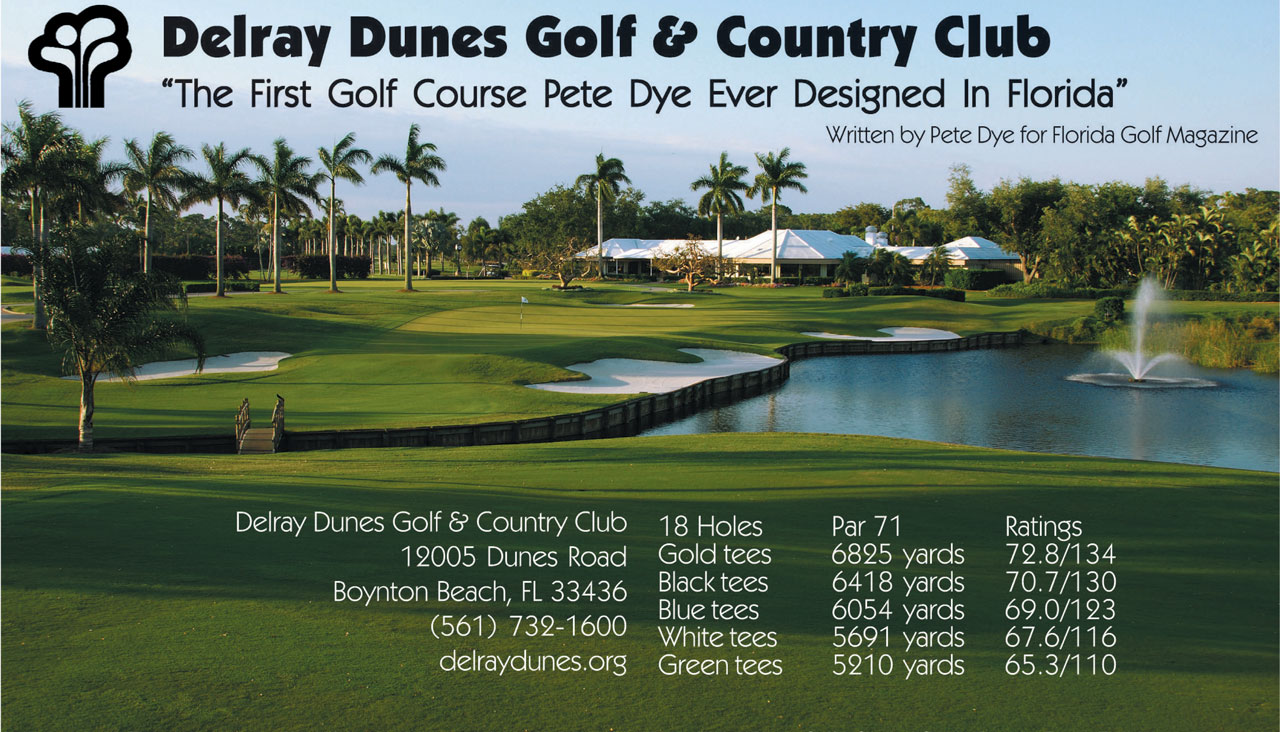 Pictured here: The approach to the 18th green is overlooked by the clubhouse at Delray Dunes Golf & Country Club in Boynton Beach Florida.
Pictured here: The approach to the 18th green is overlooked by the clubhouse at Delray Dunes Golf & Country Club in Boynton Beach Florida.
|
Delray Dunes Golf & Country Club Course Designer: Pete Dye - 1969 18 Holes, Par 71 |
||
|
Tees: Gold Black Blue White Green |
Yards: 6825 6418 6054 5691 5210 |
Rating / Slope 72.8 / 134 70.7 / 130 69.0 / 123 67.6 / 116 65.3 / 110 |
Delray Dunes Golf & Country Club in Boynton Beach was the first golf course I ever designed in Florida. That was back in 1969, and though Alice (my wife & design partner) and I might never reveal which one of the many courses that we’ve designed is nearest to our hearts, it’s an absolute fact that Delray Dunes is closest to our home in nearby Gulfstream, Florida and that’s got to count for something.
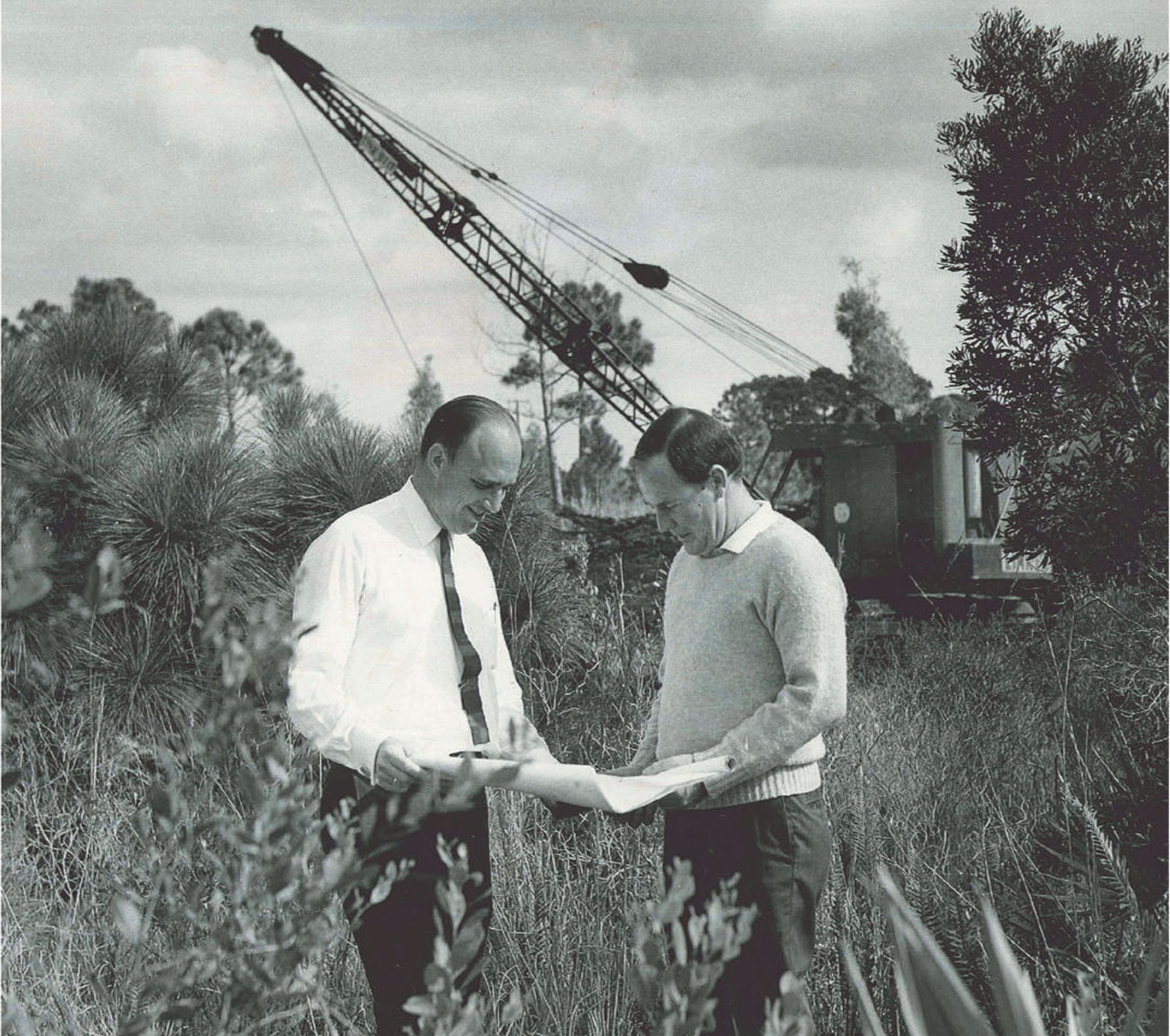 1969, John Dodge, one of the founding members at Delray Dunes and Pete Dye are pictured here discussing topographical blueprint details while a huge dragline works in the background.
1969, John Dodge, one of the founding members at Delray Dunes and Pete Dye are pictured here discussing topographical blueprint details while a huge dragline works in the background.
Drive into Delray Dunes, between the big shade trees and through the 24-hour manned security gate and you’ll see something a little unusual, even for a country club subdivision. There are wide open views of the golf course. Here in this 40-some-year-old community, the immaculately well-kept course takes center stage. It isn’t hidden behind homes. It’s right in the middle of the neighborhood, flanked by trees and the road. We designed it that way because we didn’t want the golf course to be separate.
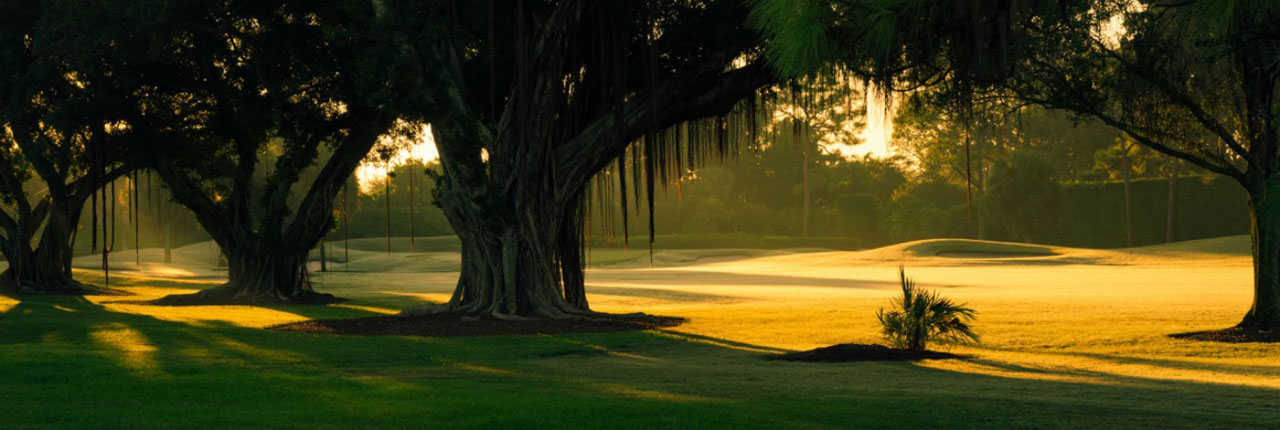
The club members and homeowners are avid players, so the course gets plenty of play, some 25,000 rounds annually, yet conditioning remains meticulous. Divots and unattended ball marks are few, underscoring a commitment to excellence by an involved membership.
The course at Delray Dunes measures 6,843 yards from the back tees. For the good player, it’s a challenging par 71 that plays strong all the way back, but the way we have the course set-up, it is very playable for the higher handicap players. There are few forced carries, and a pitch-and-run shot onto the putting surface is an option on almost every hole. Also, most of the fairways are pretty liberal (wide) and peripheral containment mounding will often kick an offline approach shot back toward the ample sized greens. Most of the cart-paths are made of a coquina-type aggregate material, so it can be played from very much like a waste bunker, plus golf balls won’t make such a big bounding bounce when they hit this softer cart-path.
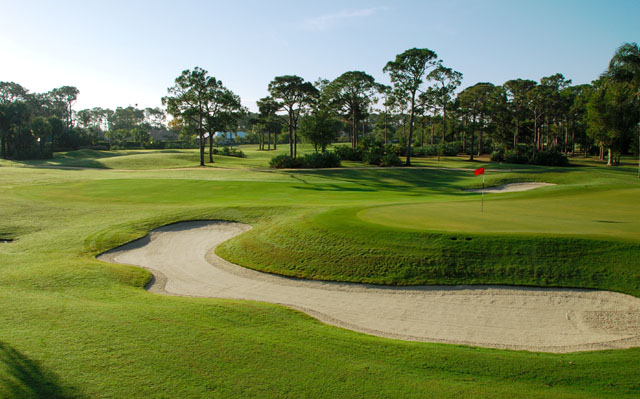 The first par 3 at Delray Dunes is this 158-yard 3rd hole which has a slightly elevated green with deep bunkers right and left.
The first par 3 at Delray Dunes is this 158-yard 3rd hole which has a slightly elevated green with deep bunkers right and left.
The golf course at Delray Dunes is constantly improving. I gave it a major makeover in 1977. Other changes result from my evolving ideas, the storms passing that remove trees, and utilitarian concerns like expanding the driving range or adding a short game practice area. When asked, members will tell you, ‘The course plays markedly different year to year.’
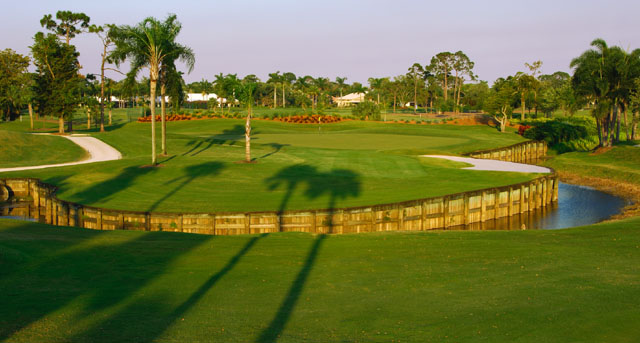 From the 8th tee Delray Dunes beautiful new clubhouse can be seen in the distance for the first time since the first tee. But the real star of this hole is the forced carry over water to this bulk-headed island green. At 320 yards from the back tees many golfers dream of potentially driving this par 4
From the 8th tee Delray Dunes beautiful new clubhouse can be seen in the distance for the first time since the first tee. But the real star of this hole is the forced carry over water to this bulk-headed island green. At 320 yards from the back tees many golfers dream of potentially driving this par 4
I play golf with friends at Delray Dunes when I can, but while the golf course is a delight to play, with its generous housing setbacks, vividly framed holes, and very little encroaching water, a large part of the appeal is the club itself and its members. I also go back to Delray Dunes every year or so and fix or change things, like changing the contour of a green, reconfiguring a hole, adding or removing trees and mounds, or putting in a bunker and so forth.
Alice and I both still have a special feeling for Delray Dunes, the first course I ever designed in Florida, and I’m always interested in what’s going on there. I guess that’s why I’m always stopping by, offering suggestions, and making improvements. I want the course to be the best it can be, and it’s a labor of love for me to continue refining the course.
- Pete Dye, 2013

Pete Dye’s Design Notes: - Delray DunesHole #1: Par 4, Hndcp 5, Gold 385, Black 385, Blue 370, White 357, Green 330The 1st hole at Delray Dunes Golf & Country Club is well-defined by beautiful large Ficus and Oak trees that we planted 40 years ago, on both sides of its comfortably wide fairway making it a beautiful and very playable starting hole for the members. From the back tee it is 385 yards to the hole, but playing from the forward tees is a bit easier at 330 yards. With a couple of bunkers on the right side of the fairway, I would say that it’s a good idea to keep your tee-shot to the left, giving you a clear shot at the two-tiered first green. The 1st green is mildly contoured compared to some of the more undulating greens on the course, but it’s still fast. Fast green-speeds are a well respected part of Delray Dunes’ tradition, and the superintendent there does a great job at keeping the TifEagle greens stimping anywhere from 11 to 12 feet of roll in the height of season. Hole #2: Par 4, Hndcp 13, Gold 417, Black 390, Blue 349, White 334, Green 317The 2nd hole is another stunning tree-lined par 4 into the prevailing wind. Most courses usually run about 300 yards in fairway width before the trees and fairway bunkers are added, but at Delray Dunes we made the fairways about 400 yards wide and that extra hundred yards seems like a mile, when it comes to planting trees. We planted allot of trees on #2, but much like the first hole, the 2nd hole also has plenty of room on the right, making it easier for everyone to stay in bounds. The 2nd fairway is further defined by an immense fairway bunker to the left of the landing area and beautifully sculptured mounding on the right side of the fairway. The large narrow putting surface is sloped from back to front, so it receives balls well. Hole #3: Par 3, Hndcp 17, Gold 158, Black 158, Blue 150, White 133, Green 110The first par 3 at Delray Dunes is the 158-yard 3rd hole which has a slightly elevated green with deep bunkers on both the right and left. Its undulating putting surface is sloped mostly from left back to the right front with a fall-off on the right side into the large bunker. Hole #4: Par 5, Hndcp 1, Gold 550, Black 538, Blue 495, White 473, Green 419The 4th hole is rated as the hardest hole at Delray Dunes. I rebuilt this 550 yard monster a few years ago adding two deep fairway bunkers about 295 yards out on the right forcing the long-hitters to aim their tee shot more to the left. This makes the hole a double dogleg, playing more like a true 3-shot hole than it did before. The very narrow green requires the second shot to be placed to the right avoiding a pond on the left side leaving the best angle for the third shot. Then, with a bunker left of the green and a deep grass bunker on the right, you better make sure your third shot is accurate. Hole #5: Par 4, Hndcp 3, Gold 377, Black 357, Blue 340, White 324, Green 302One of my favorite things about the 5th hole is a massive old Ficus tree that partially shades the back tee with its great broad limbs. It’s a beautiful tree and #5 is a beautiful golf hole which looks like it’s secluded somewhere out in the middle of the woods. Actually it runs alongside of a busy road, but you’d never know it, because the entire right side of the golf hole is planted with native trees and backed by a combination of sloping berms of earth and a 20 foot high thick Ficus hedge. At 377 yards from the back tees the 5th hole is a short par 4 dogleg left, yet it is still rated the 3rd hardest hole on the course. With fairway bunkers both right and left, accuracy is most important off the tee. The second shot calls for an exacting iron shot that avoids the bunker on the right side of the elevated green. The heavily undulating putting surface of the 5th hole is sloped severely right to left and the back of the green falls-off toward a difficult collection area behind the green. Hole #6: Par 4, Hndcp 7, Gold 483, Black 405, Blue 389, White 372, Green 308The sixth hole is the longest par 4 hole at Delray Dunes but is rated as the 7th hardest. It’s a slight dogleg right that measures 483 yards from the back tees, but 308 from the forward tees. Lined with trees on both sides of the fairway, the 6th hole has a large fairway bunker on the right of the landing area and two small bunkers to the left, making this a well defined fairway that demands an accurate tee shot. Up toward the green there are three more bunkers along the left side of the fairway and another large bunker left of the green. When viewed from the middle of the fairway, the 6th green is nicely defined by the many beautiful large trees behind the green. But you’ve got to remember, the putting surface slopes from the front right to the back left. Hole #7: Par 3, Hndcp 15, Gold 218, Black 190, Blue 169, White 151, Green 119The 7th Hole is the second par three on the front nine. It’s a tough 218 yards from the back tees with a forced carry over a large bunker guarding the front of the green. The elevated tee gives the golfer a great view of the green with large palm trees behind it. The 7th green also has several tricky pin placements. Hole #8: Par 4, Hndcp 11, Gold 320, Black 320, Blue 306, White 301, Green 284From the 8th tee Delray Dunes beautiful new clubhouse can be seen in the distance for the first time since the first tee. But the real star of this hole is the forced carry over water to a bulk-headed island green. At 320 yards from the back tees many golfers dream of potentially driving this par 4, but I personally would suggest you lay-up a 200 to 210 yard tee shot, short of the water, leaving a wedge-shot over the water and the approach area to the green which is set-back and guarded on the front right and front left by sand, and water on the right. Water doesn’t come into play very often here at Delray Dunes, but the few lakes and ponds that are on and around the course are connected by steep banked canals that also border the golf course property. The golf course maintenance crew at Delray Dunes doesn’t mow any of the steep canal banks that connect the lakes and border the property; we just let them grow native. It provides habitat for the ducks and other native wildlife. You might not want to look for your golf ball down there among the palmettos but the wildlife loves all that native vegetation. Exemplary environmental policies have long been a tradition at Delray Dunes. The club uses reclaimed water, exclusively for all of its golf course irrigation. The city of Boynton Beach supplies the reclaimed water (which is basically waste water after it’s been treated), through a big pipe directly to Delray Dunes’ pump station which then ups the pressure and supplies the irrigation for both the golf course and the clubhouse. The superintendent at Delray Dunes also uses an environmentally friendly waste water treatment and recycling system that the club purchased for washing all Delray Dunes’ mowers and equipment. So, basically they have a big tank that they fill up with water only once. Then, they wash their equipment at a specially built containment area that catches all that wash water and recycles it into a tank which has special microorganisms added to it that break down the petroleum products, chemicals, grass clippings and such and then filters it for reuse again. So therefore, none of the wash-water from the mowers or spray-rigs ever contaminates the lakes or ponds. Hole #9: Par 4, Hndcp 9, Gold 424, Black 375, Blue 334, White 308, Green 295The thickness of the surrounding treeline makes the 9th hole a memorable test of the game. This beautifully wooded par 4 is a dogleg right that measures 424 yards into the prevailing wind and I would suggest keeping your tee shot to the left side of the fairway due to the tall oaks and palm trees at the dogleg on the right. This is a tight driving hole, but there’s plenty of room left of the landing area for the higher handicap golfers. It takes an exacting tee shot and a precise second shot to land and stay on this devilish green. The putting surface is bunkered on the left and falls-off on the right side to a collection area. Hole #10: Par 4, Hndcp 12, Gold 381, Black 354, Blue 333, White 308, Green 301I’ve rebuilt the 10th hole three times over the past 40 years but this last time I think we got it right. It used to be a dogleg right, but moving the tee way left and back behind the canal has given us ample room to make the driving range considerably wider and longer, plus add a new practice area and short game range. The opening hole of the back nine is a slight dogleg left par 4 and a real birdie opportunity. From the back tees it plays at 381 yards with a forced carry over a canal to a wide well defined landing area, with fairway bunkers both left and right. There is water in the form of a pond short of the green on the right side and more bunkers both left and right of the green which is well defined by trees in the background. The 10th green is heavily contoured so putt carefully. Hole #11: Par 4, Hndcp 14, Gold 378, Black 378, Blue 353, White 335, Green 324The 11th is a short straight par 4 hole and even though there are very few flat lies on its undulating fairway, the green is wide open in front, so the higher handicap player can get there in two. From the tee you can see the large trees behind the green and a lateral hazard behind the green will catch errant second shots that go long. As you approach the green you’ll see a bunker left of the green and several large mounds that do a beautiful job of framing the green. The 11th green also is sloped from back to front and receives shots well. So, at only 378 from the back tees, this hole is another excellent birdie opportunity. Hole #12: Par 5, Hndcp 2, Gold 569, Black 533, Blue 515, White 455, Green 432The beautiful 12th hole is rated as the second hardest hole at Delray Dunes. At 569 yards from the back tees, it’s the longest of the three Par 5s and has beauty as well as challenges all the way. Gorgeous trees lining the fairway both left and right demand an accurate tee shot and second shot. Off the tee, it has a forced carry over a canal that crosses in front of the forward tees and from the back tees it’s 180 yards to the fairway. Bunkers left and right of the landing area also make accuracy necessary off the tee. Further down the fairway, a large fairway bunker on the right also makes the landing area for your second shot a little tight. The green which is bunkered on the left hand side is framed very well by palm trees and ornamental vegetation behind the green giving this hole some nice definition as you approach it. This two tiered green provides a lot of excellent hole locations and its tricky putting surface also slopes dramatically off at the back and on the right hand side. Hole #13: Par 4, Hndcp 10, Gold 440, Black 410, Blue 399, White 371, Green 351The lucky 13th hole is the second longest par 4 on the back nine; it’s a 440 yard dogleg right into the prevailing wind. Two fairway bunkers to the right of the landing area make it necessary to keep your tee-shot left. Further down the fairway a bunker on the left helps define the left side of the fairway but also gives you a good target to aim for off the tee. For most players the bunker on the left is out of play off the tee. The bunkers on the right side do come into play however, making it necessary to keep the ball left off the tee. The 13th green is pretty good size and one of the flattest putting surfaces on the course, but the out-of-bounds on the right side of the green, and greenside bunkers both left and right make an accurate shot into the green imperative. Hole #14: Par 3, Hndcp 18, Gold 200, Black 174, Blue 162, White 153, Green 132The 14th hole, which is the first par 3 on the back nine plays at 200 yards from the back tees. This hole is bunkered heavily on the left hand side and behind the green, intimidating golfers into hitting their tee-shot to the right side of the green or fairway. A deep swale directly to the right of the green also falls-off dramatically into a large catch-area or “grass hole” that is about five feet below the green. This large green is another one of the flattest putting surfaces on the course and definitely is a birdie opportunity. Hole #15: Par 5, Hndcp 4, Gold 495, Black 495, Blue 483, White 463, Green 415The 15th is a tight driving hole because of the bunkers on the left and it doglegs right to left. So the good player has a more strategic drive than on any other hole on the course. This 495 yard par 5 curves to the left around significant fairway bunkers and trees. An accurate drive will allow the longest hitters to get home in two with a very accurate second shot. Bunkers down the left side and pot bunkers on the right side require a well placed second shot for most players leaving a shot of 50-100 yards into the green that slopes mildly from lower left to upper right. Hole #16: Par 4, Hndcp 8, Gold 470, Black 438, Blue 405, White 388, Green 371The longest par 4 on the back nine is the 16th hole at 470 yards from the back tees. The tee shot normally hits an upslope which leaves a very long second shot to a large green. The green is guarded by sand left and a grass hole right. The 16th is a long, hard hole, a par here is a very good score. Hole #17: Par 3, Hndcp 16, Gold 183, Black 174, Blue 157, White 138, Green 115The second par 3 on the back nine, the 17th hole, is a beauty. From the back tees it measures 183 yards into the prevailing wind to an elevated green that slopes left to right. A deep pot bunker protects the left side of the green and a large bunker runs all along the backside, behind the green. I would say that a high shot to this tricky undulating green is your best bet for a par or birdie. Hole #18: Par 4, Hndcp 6, Gold 395, Black 395, Blue 345, White 327, Green 285On #18 we built a new back-tee at 395 yards which is tucked way back, almost-behind the 17th green. This beautiful finishing hole requires an accurate tee shot to a two tiered fairway. Shooting down to the green from the left upper tier leaves the best view of the green protected by water and bunkers right and bunkers left and behind. A shot that misses the green left or long leaves a difficult pitch to the large green. Backed by beautiful large Royal Palm trees, the amphitheater green makes for a superb closing hole for members watching tournaments. Players like Jack Nicklaus, Gary Player, Lee Trevino, Tom Watson, Raymond Floyd, Fuzzy Zoeller and Beth Daniel are just a few of the many celebrity golfers that have participated in the many charity Pro Am tournaments held at Delray Dunes over the last 40-some years. |


